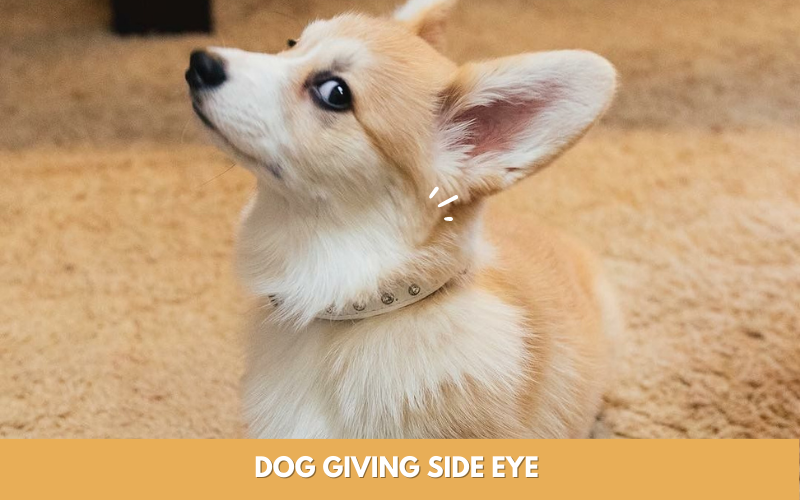Dog giving side eye is a behavior that many dog owners are familiar with. If you’ve ever caught your furry friend looking off to the side with a sideways glance, you know that this can be a sign of many different things, from suspicion to annoyance to playfulness. But what exactly is side eye, and why do dogs give it? In this article, we’ll explore the world of dog giving side eye, keep reading!
What does dog side eye mean?
Side eye is a term used to describe a glance or look that is given sideways, often with a slightly turned head or squinted eyes. In the context of dogs, side eye is a common body language signal that they use to convey various emotions or intentions.
Types of side eye
There are several types of side eye that dogs might give, including:
- Playful side eye – This is when a dog gives a quick glance to signal that they are ready to play or engage in a game.
- Suspicious side eye – A dog may give suspicious side eye when they are unsure or uncomfortable with a situation or person.
- Dominant side eye – This is a more intense side eye that is often used by dogs to assert their dominance or challenge another dog or person.
- Defensive side eye – A dog may give defensive side eye when they feel threatened or cornered and are preparing for a potential attack.
Examples of dog giving side eye
Examples of when a dog might give side eye include:
- When they are approached by a stranger or unfamiliar person
- When they are introduced to a new dog or animal
- When they are playing with another dog and are trying to establish dominance
- When they are feeling threatened or uncomfortable in a particular situation or environment.
It is important to understand the context and other body language cues that a dog is giving when they give side eye in order to accurately interpret their intentions and avoid any negative interactions.
Do all dogs give side eye?
Not all dogs give side eye, and it may be more common in some breeds than in others. However, side eye can be a natural behavior in many dogs, as it is part of their body language and a way of communicating with other dogs and people.
As for specific breeds:
Dachshund side eye
Dachshunds are known for their expressive faces and may give side eye as a way of communicating their feelings or intentions. They may be particularly prone to giving side eye when feeling curious or unsure about a situation.
Corgi side eye
Corgis are also known for their expressive faces and may give side eye when feeling playful, curious, or wary of a situation or person. They may also use side eye as a way of seeking attention from their owners.
Beagle side eye
Beagles are social dogs that enjoy interacting with their owners and may use side eye as a way of communicating their desire for attention or interaction. They may also give side eye when feeling uncomfortable or unsure about a situation.
Bulldog side eye
Bulldogs are known for their wrinkled faces and may give side eye as a way of communicating their feelings or intentions. They may be particularly prone to giving side eye when feeling cautious or unsure about a situation or person.
Why does my dog side eye me?
There could be several reasons why is dog giving side eye:
Feeling uncomfortable or threatened
If your dog is feeling uncomfortable or threatened, they may give you side eye as a way of avoiding direct eye contact, which can be seen as a sign of aggression in the animal kingdom. This could happen if you are doing something that makes your dog feel scared or uneasy, such as yelling or getting too close to them.
Seeking attention
Dogs are social animals and often crave attention and interaction from their owners. If your dog wants your attention, they may give you side eye as a way of communicating their desire to interact with you.
Trying to read your body language
Dogs are very attuned to their owners’ body language and may use side eye as a way of trying to read your emotions or intentions. They may be looking at your facial expressions or other cues to try to understand what you are thinking or feeling.
Being playful
Sometimes, dogs may give side eye as a playful expression, especially if they are playing with you or another dog. This type of side eye is often accompanied by a wagging tail and an open mouth.
In general, when a dog giving side eye, it’s important to pay attention to their body language and try to understand what they might be feeling or trying to communicate. If your dog seems uncomfortable or scared, it’s important to give them space and avoid doing anything that might make them feel more anxious or uneasy.
Body language that goes with side eye
When a dog gives side eye, they may also display other body language cues that can help you understand what they are feeling or trying to communicate. Some common body language cues that may accompany side eye include:
- Tilted head: Dogs may tilt their head to the side when giving side eye, which can indicate curiosity or confusion.
- Ears flattened back: If a dog is feeling scared or threatened, they may flatten their ears back against their head.
- Stiff body posture: Dogs that are feeling uneasy or uncomfortable may have a stiff body posture, with their muscles tensed and their tail held high or tucked between their legs.
- Avoiding eye contact: Dogs that are feeling nervous or submissive may avoid eye contact, looking at the other dog or person from the corner of their eye instead.
- Growling or baring teeth: In some cases, side eye may be accompanied by growling or baring teeth, which can be a sign of aggression or fear.
You should also pay attention to all of your dog’s body language cues, not just side eye, to get a full understanding of what they are feeling and trying to communicate. If your dog is displaying signs of fear or aggression, it’s important to give them space and avoid doing anything that might escalate the situation.
What to do when dogs giving side eye?
When a dog gives side eye, their intention may not always be clear, and it’s important to respond appropriately to avoid escalating the situation or causing your dog to feel threatened or uncomfortable. Here are some appropriate reactions to side eye:
- Avoid direct eye contact: If your dog is giving you side eye, try to avoid direct eye contact, as this can be seen as threatening in the animal kingdom. Instead, look away or look down to show your dog that you are not a threat.
- Give your dog space: If your dog is feeling uncomfortable or threatened, give them some space and avoid approaching them. This can help your dog feel more secure and prevent them from feeling the need to defend themselves.
- Try to understand your dog’s body language: When your dog gives you side eye, try to read their other body language cues to get a better understanding of what they might be feeling or trying to communicate. This can help you respond appropriately and avoid doing anything that might escalate the situation.
- Offer positive reinforcement: If your dog is giving you side eye as a playful or attention-seeking behavior, offer positive reinforcement, such as treats or praise, to encourage good behavior.
- Seek professional help: If your dog’s side eye is accompanied by other aggressive or fearful behaviors, it’s important to seek professional help from a veterinarian or a certified dog behaviorist. They can help you identify the underlying cause of your dog’s behavior and develop a training plan to address it.
Differences between side eye and side glance
Here’s some of the key differences between side eye and side glance:
| Aspect | Side Eye | Side Glance |
| Definition | A sideways glance or look that may communicate suspicion, annoyance, or discomfort | A quick sideways look or glance, often used to check one’s surroundings or acknowledge someone |
| Intention | May communicate negative or ambiguous feelings | May be neutral or positive in nature |
| Body Language | May be accompanied by other signals such as raised eyebrows, tense body posture, or lip licking | Typically involves a quick and subtle turn of the head or eyes |
| Context | Often used in social or communication situations | Often used in observational or situational contexts |
| Perception | May be perceived as confrontational or negative | May be perceived as curious or friendly |
Dog giving side eye meme
The “dog giving side eye” meme has become a popular and humorous way to capture the playful and sometimes sassy nature of our furry friends. These memes typically feature a photo of a dog looking off to the side with a sideways glance, often with a caption or humorous text overlay. Here are some popular dog giving side eye meme:




FAQs
Can side eye be a sign that my dog is feeling jealous or possessive?
It is possible that your dog’s side eye may be a sign of jealousy or possessiveness, especially if they are directing it towards another dog or person that they perceive as a threat to their resources (such as food, toys, or attention). However, it is important to look at your dog’s overall body language and behavior to get a better understanding of their motives.
Should I be worried if my dog frequently gives side eye?
It depends on the context and the severity of the behavior. If your dog’s side eye is accompanied by other signs of discomfort or aggression, such as growling or biting, then it may be a cause for concern. However, if your dog’s side eye is more subtle and occasional, it may simply be a part of their natural communication style.
Is side eye always negative?
Not necessarily. While side eye can sometimes be a sign of discomfort or aggression, it can also be a playful or curious behavior. It is important to consider your dog’s overall demeanor and body language to interpret the meaning behind their side eye.
Can side eye be a sign of illness in dogs?
In some cases, a sudden change in your dog’s behavior, including giving frequent side eye, could be a sign of an underlying illness or discomfort. It is important to take note of any other changes in your dog’s behavior or physical condition and to consult with a veterinarian if you are concerned about their health.
Conclusion
Generally, dog giving side eye is a fascinating aspect of canine body language that can communicate a wide range of emotions and intentions. While it’s important to understand the context and other body language cues when interpreting side eye, it can be a useful tool for pet owners to better understand and communicate with their furry companions. Furthermore, the phenomenon of dog giving side eye adds yet another layer of complexity and delight to the already rich tapestry of human-dog relationships.

